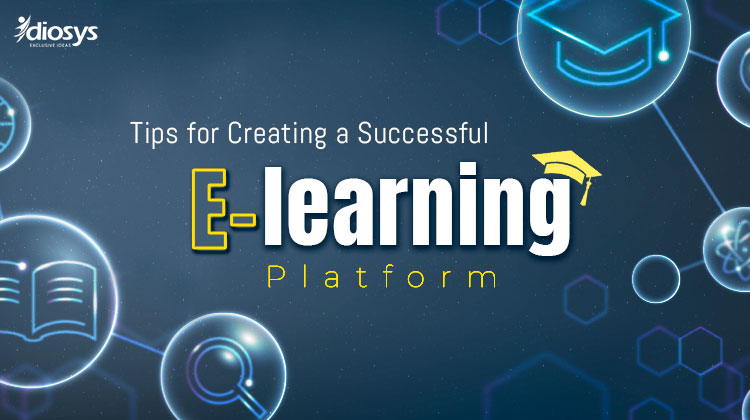Tips for Creating a Successful E-learning Platform
In the ever-changing world of today, education no longer takes place only in conventional classrooms. E-learning platforms have become extremely effective instruments that personalise learning experiences and democratise access to knowledge. If you have a burning desire to create your own e-learning platform, this blog is your road map; it is full of helpful advice that will help you succeed.
This blog explores the essential components of creating a successful e-learning platform, giving you insightful knowledge and useful advice. These tips will assist you in navigating the fascinating field of e-learning platform creation, regardless of your experience level as an educator or your aspirations as an entrepreneur.
1. Breaking Down the Landscape
Before taking the first step, it’s crucial to grasp the core concepts you’ll be working with. E-learning platforms function as online ecosystems facilitating structured learning experiences. They encompass a range of features, including course hosting, learner management, assessment tools, and interactive elements.
E-learning platform development entails constructing this ecosystem, encompassing designing, coding, and launching the platform. This process can involve building from scratch, using pre-built solutions, or leveraging a combination of both approaches.
2. Finding Your Niche:
Success in any field hinges on understanding your audience’s needs. In the e-learning realm, this translates to identifying your target learners. Are you aiming for professional development courses, K-12 education solutions, or skill-specific training modules? Each audience segment has unique preferences, learning styles, and content expectations.
Furthermore, defining your content focus is paramount. Will you curate content yourself, invite guest instructors, or offer a marketplace for independent creators? Each approach presents its own set of advantages and challenges. Carefully consider your resources, expertise, and long-term vision when making this decision.
3. Building Engaging and Effective Learning Experiences
At the heart of any successful e-learning platform lies high-quality content. This encompasses not only the information itself but also the way it’s presented. Strive to create engaging experiences that cater to diverse learning styles. Utilize varied formats such as videos, interactive quizzes, infographics, and downloadable resources. Ensure your content is accurate, up-to-date, and relevant to your target audience’s needs.
Invest in microlearning strategies by dividing content into bite-sized modules that are easily digestible and promote knowledge retention. Gamification elements like points, badges, and leaderboards can further enhance engagement and motivation.
4. Choosing the Right Platform and Tools
With your content strategy in place, it’s time to select the platform that will house your e-learning empire. Numerous options exist, ranging from Learning Management Systems (LMS) like Moodle and Canvas to custom-built solutions.
Consider factors like scalability, customization options, ease of use, and integration with your existing infrastructure. Explore free and open-source solutions for budget-conscious projects, or partner with dedicated development firms for tailored experiences.
Remember, the platform is your backbone. Choose one that empowers you to deliver your vision effectively.
5. Creating an Intuitive and Accessible Platform
First impressions matter, and in the digital world, a platform’s UX holds the key to user engagement and retention. Strive for a clean, intuitive interface that allows learners to navigate effortlessly. Utilize clear menus, well-organized categories, and a logical course progression.
Prioritize accessibility by employing features like closed captions, text-to-speech conversion, and alternative text descriptions for images. This opens your platform to a wider audience and fosters inclusivity.
6. Building a community
Learning doesn’t have to be a solitary pursuit. Consider incorporating community features like discussion forums, chat rooms, and collaborative projects. This encourages interaction, peer-to-peer learning, and a sense of belonging among your learners.
Utilize social media integration to extend your reach and create a buzz around your platform.
7. Reaching Your Target Audience and Driving User Acquisition
Building a successful platform hinge not only on its content and functionality but also its visibility. Develop a comprehensive marketing strategy that aligns with your target audience. Leverage social media, content marketing, search engine optimization (SEO), and email marketing to reach potential learners.
Offer free trials, introductory courses, and webinars to showcase your platform’s value. Partnerships with industry influencers and educational institutions can further expand your reach.
8. Continuously Improve and Innovate
Remember, success is not a destination but a journey. Actively seek feedback from your learners through surveys, reviews, and direct communication. Analyse user data to identify areas for improvement. Be open to adapting your content.
Building an e-learning platform can be a rewarding experience, empowering individuals, and communities with the gift of knowledge. By following these tips, you’ll be well-equipped to navigate the development journey and create a platform that shines brightly in the ever-evolving world of e-learning.
——————————————————————————————————
What are the first steps in creating an e-learning platform?
Identify your target audience, define your learning objectives, and research the market.
What features are essential for an e-learning platform?
User-friendly interface, course management, multimedia support, assessments, and progress tracking.
Should I build my platform from scratch or use a pre-built solution?
Using a pre-built solution is quicker and often cheaper, while building from scratch offers more customization.
How do I secure my e-learning platform?
Use SSL certificates, regular backups, secure payment gateways, and strong password policies.
How do I track the performance of my e-learning platform?
Use analytics tools to monitor user engagement, course completion rates, and feedback.
How important is mobile compatibility for an e-learning platform?
Very important, as many learners access content on mobile devices. Ensure your platform is mobile-friendly.
——————————————————————————————————
You May Also Read
10 Must-Have Features for an Event Management Application in 2023
